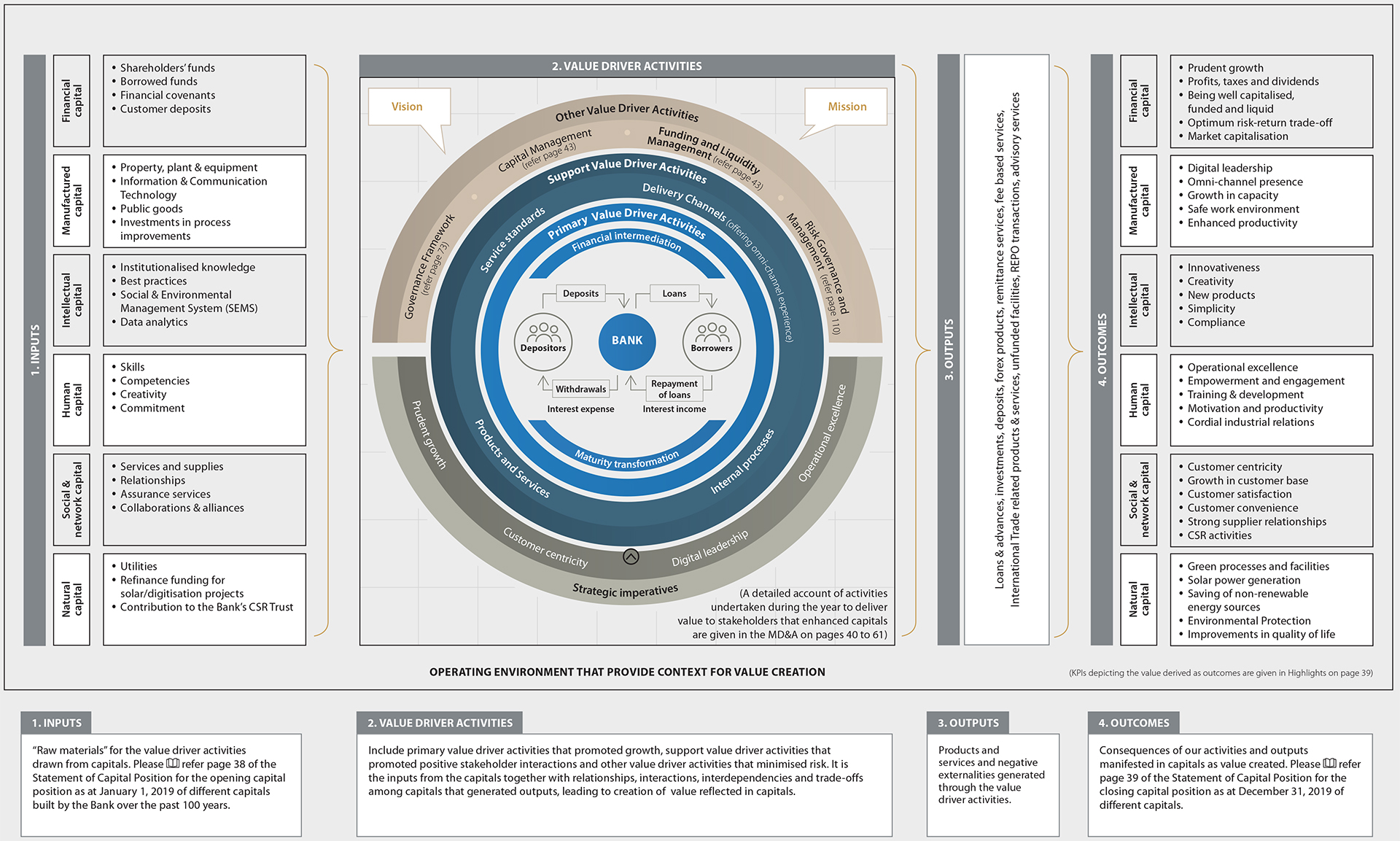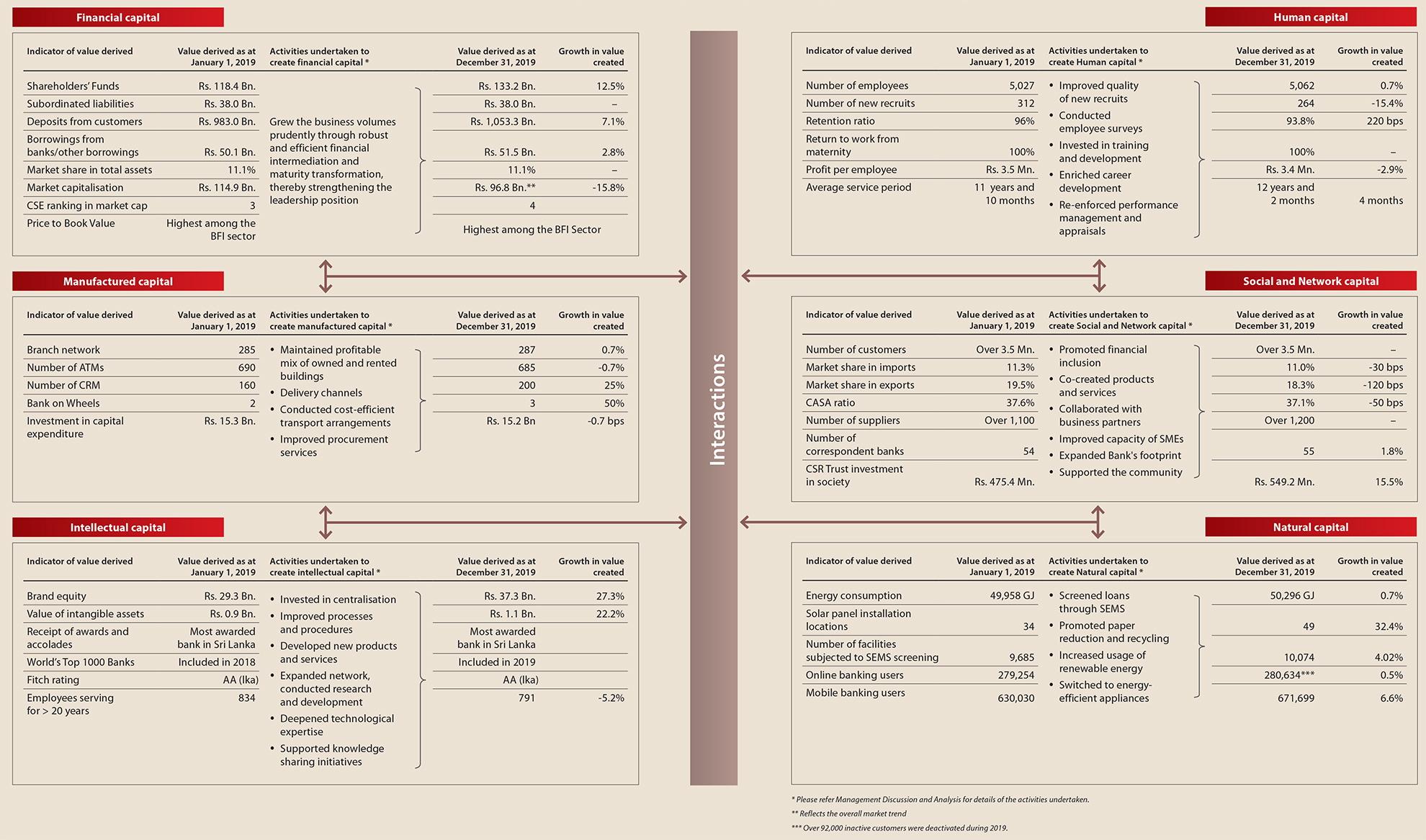Business model of the Bank revolves around the two primary value driver activities of financial intermediation and maturity transformation. They directly accounted for 71.51% of the total operating income, 66.35% of total assets and 83.98% of liabilities as at December 31, 2019. However, since the Bank accommodates few walk-in customers, a substantial portion of the rest of the operating income, assets and liabilities too arose from or related to these two activities. A number of other value driver activities enhance the quality of stakeholder interactions and minimise risk.
Financial intermediation and maturity transformation
Financial intermediation refers to the intermediary role the Bank plays between various stakeholders – depositors and borrowers in particular that enable channelling savings into investments. Maturity transformation refers to the process of converting short-term funds into long term lending and investments. These are two activities essential for economic development of the countries through efficient allocation of resources by ensuring credit reaches the needy without jeopardizing the interests of those who invest such funds.
Capitals
By sustainably delivering and deriving value over a century of its existence, the Bank has been able to build a base of loyal stakeholders and “stocks of value” we respectfully call “capitals”. Besides financial and intellectual capitals that reside within the Bank, these include manufactured, human, social & network and natural capitals. It is these capitals that provide “inputs” for our value driver activities that enable delivery of value to and deriving of value from the stakeholders. Similarly, it is in these capitals that the “outcomes” and consequences of our activities leading to value creation manifest.
Statement of capital position
The activities we undertake in furtherance of financial intermediation and maturity transformation and the consequent interactions among the capitals augment the capitals, a reflection of value created. See Table 07 for the Statement of Capital Position of the Bank as at January 1, 2019 and December 31, 2019 and growth during the year that reflect the value created during the year.
Besides the value derived as reflected in the enhanced positions of the other capitals, the two broader categories of income – net interest income from fund-based operations and fee and commission income from fee-based operations – enable the Bank to enhance its financial capital. Fund based operations involve the process of mobilising funds from depositors and borrowing from others incurring interest expenses and lending such funds to borrowers and investors earning interest income. The interest margin which is the difference between the lending rate and the borrowing rate compensates the Bank for credit risk, funding risk and interest rate risk. All other services provided by the Bank not involving funds are fee-based operations. Reflecting efficient financial intermediation, the Bank generated 71.51% of its total operating income by way of net interest income (70.57% in 2018).
Gearing
Financial intermediation and maturity transformation cause the business model of banks to substantially differ from other corporates. Principal difference is the substantially lower Return on Assets (ROA) which is less than 2% in general in stark contrast to between 10% – 20% earned by corporates in other sectors. This prompts banks to resort to the process of gearing in order to make the returns to the investors attractive in terms of Return on Equity (ROE). Gearing involves expanding the business volumes by mobilising more and more funding from depositors and other providers of funds to the banks and lending or investing such funds to grow the loan book, and investment portfolios on the strength of a given amount of capital.
Gearing primarily remains the foundation of our business model, which enables us to operate at around 10 times higher business volumes compared to the shareholders’ equity. It is our license to mobilise deposits from the public that has made it possible. However, we are well aware that gearing exposes the Bank to a multitude of internal and external risks. In addition, certain emerging global developments are now threatening to disrupt this conventional business model. As explained later in the report, the Bank has established a sound risk management framework with necessary oversight of the Board of Directors and thereby has been able to successfully manage such risks.
Stakeholder returns
As shown in Table 07, Commercial Bank has been able to improve its profitability over the years while prudently maintaining gearing at acceptable levels. This improvement in profitability reflects the net impact of the value we have been able to create by delivering value to and by deriving value from our stakeholders. From investors’ perspective, this value creation is reflected in the returns the Bank has been able to generate for them in terms of earnings, dividends and appreciation in market price of shares. The market capitalisation of the Bank’s shares remained the highest among the Banking, Finance and Insurance institutions as at end 2019 while its shares ranked fourth among all listed companies in the Colombo Stock Exchange as at end 2019. Further details on the performance of the Bank’s shares are found in the section on “Investor Relations”.
While growing organically and in the domestic market, the Bank has taken steps to leverage inorganic and regional growth opportunities, primarily to geographically diversify its risk exposures and sources of revenue and thereby enhance its sustainability of operations and long-term value creation. These efforts have now made the Bank a well-established regional bank.
The Bank’s business model that delivers value to and derives value from the stakeholders, leading to sustainable value creation
Figure – 07

Statement of Capital Position
Table – 07







